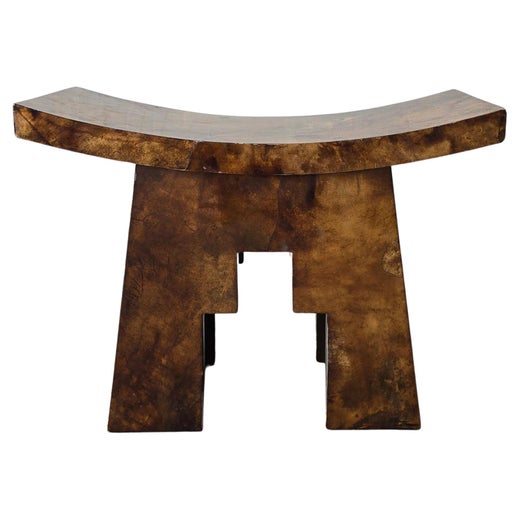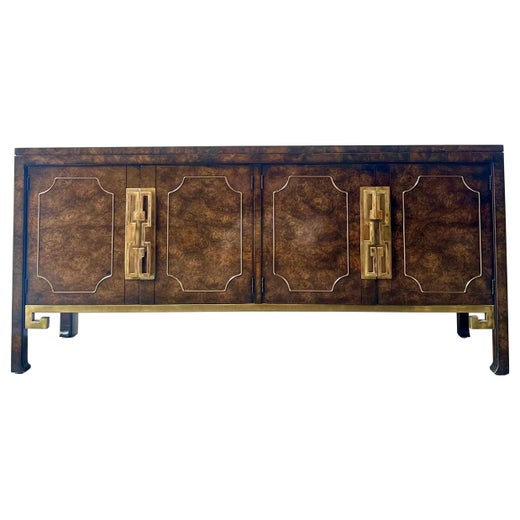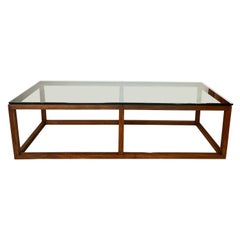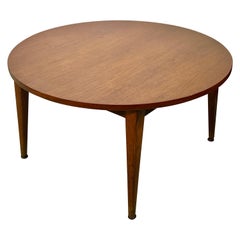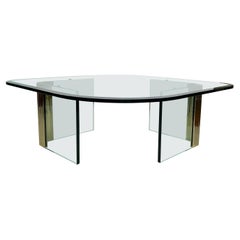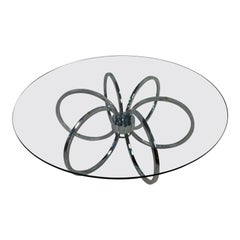Mastercraft Style Asian Inspired Brass Coffee Table
About the Item
- Creator:Mastercraft (Maker),Karl Springer (Designer)
- Dimensions:Height: 15.5 in (39.37 cm)Width: 36 in (91.44 cm)Depth: 36 in (91.44 cm)
- Style:Mid-Century Modern (Of the Period)
- Materials and Techniques:
- Place of Origin:
- Period:
- Date of Manufacture:1970s
- Condition:Wear consistent with age and use. Minor losses. the table is in very good shape for its age. It does show wear normal and consistent with age. Table has some oxidation and scratches as pictured. Also the glass has one very.
- Seller Location:Esperance, NY
- Reference Number:1stDibs: LU5605223859072
Karl Springer
The Berlin-born, New York–based designer Karl Springer brought a chic, high-fashion sensibility to his coffee tables, mirrors, Lucite lamps and other furnishings. During his heyday in the 1970s, Springer’s work was a favorite of the glamour set, who enjoyed the novelty of pieces finished in rich and striking materials that ranged from exotic hides and skins to lacquer and chromed metal.
In a sense, Springer was a pre-postmodernist. Much as the dull, safe, corporate sameness of late 20th-century modernism prompted Ettore Sottsass, Michael Graves and others to explore new and provocative structures and materials in design and architecture, so, too, was Springer driven to enliven his creations with fresh and alluring energy and sleekness.
Springer came to New York in the late 1950s and found work arranging window displays at the department store Lord & Taylor. He had studied bookbinding in Germany, and, using his meticulous skills, he began crafting desk accessories wrapped in leather as a sideline. These pieces were sold in luxury stores like Bergdorf Goodman and drew a sophisticated clientele that included the Duchess of Windsor.
By 1965, Springer had established his own Manhattan atelier. It was Pierre Scapula, decorator to Jackie and Aristotle Onassis, who spotted Springer's disco-era Onassis chairs — which didn't yet have a name — first commissioned for a private residence in Acapulco, on the floor of the designer’s East 61st Street showroom. Jackie ordered barstools for the couple’s yacht, the Christina O, and dining chairs for their house on the Greek mainland.
At the time of his death, Springer had showrooms as far afield as Los Angeles, Tokyo and Munich.
The chairs, tables, credenzas and other furniture forms Springer created are generally simple, but substantial, and often have robust, rounded lines. The appeal of his work lies in Springer's insistence on exacting construction and, above all, his eye for unusual materials and finishes.
Springer employed Lucite, brass, and gunmetal along with chromed and polished steel, and revived exquisite finishes rarely seen since the days of Art Deco masters such as Émile-Jacques Ruhlmann and Jean-Michel Frank: shagreen (a type of sharkskin), python, goatskin, bone, horn, and lacquered parchment, as well as fabrics that include batik prints. Made of such materials, Springer’s work is by its very nature flamboyant and eye-catching: a suite of pieces will astonish, and an artfully placed side table in exotic hide will add a surprising spark.
Find a collection of vintage Karl Springer furniture today on 1stDibs.
Mastercraft
Compared to that other furniture-makers in historically minded Grand Rapids, Michigan, the work of Mastercraft seems positively flamboyant. The company was founded in 1947 by brothers Charles and William Doezema, who hailed from a long line of cabinetmakers. They went overseas during their service in World War II, and returned home with a plan to make furniture with cosmopolitan flair. Their firm specialized in chairs and case pieces that have modernized traditional forms, finished in exotic wood veneers such as amboyna, yew, burl and fruitwood, and trimmed in brass. Bureaus and credenzas often feature cabinet fronts with decorative brass details such as silhouettes of flowers and birds, or figures that resemble Chinese characters.
In later years, Mastercraft created chairs and glass-topped coffee tables with brass frames. Some pieces included touches like the Greek key — a motif that appears in the decorative arts of both Asian and European antiquity. After Mastercraft was acquired by industry giant Baker Furniture in 1974, the company produced a large group of case pieces featuring applied brass plaques, acid-etched with semi-abstract forms by the German-born, Vancouver-based artist Bernhard Rohne.
The latter are some of the most popular Mastercraft pieces, and like all the company’s wares range in price from about $2,000 to $12,000 depending on size, condition and the amount of decorative trim. As you will see on 1stDibs, Mastercraft furnishings made a bold but artful statement — perfect for lending a bit of dash and brawn to a contemporary decor.
You May Also Like
Mid-20th Century American Hollywood Regency Coffee and Cocktail Tables
Brass
Vintage 1970s Hollywood Regency Coffee and Cocktail Tables
Brass
Vintage 1970s American Mid-Century Modern Coffee and Cocktail Tables
Brass
Vintage 1970s Mid-Century Modern Coffee and Cocktail Tables
Brass
Vintage 1960s American Mid-Century Modern Coffee and Cocktail Tables
Brass
Vintage 1970s American Hollywood Regency Coffee and Cocktail Tables
Brass
20th Century North American Coffee and Cocktail Tables
Brass, Bronze
20th Century North American Coffee and Cocktail Tables
Brass, Bronze
20th Century Unknown Hollywood Regency Coffee and Cocktail Tables
Brass
Vintage 1970s American Mid-Century Modern Coffee and Cocktail Tables
Brass
More From This Seller
View AllVintage 1960s Belgian Mid-Century Modern Coffee and Cocktail Tables
Teak
Vintage 1960s Unknown Mid-Century Modern Coffee and Cocktail Tables
Walnut
Vintage 1970s American Mid-Century Modern Coffee and Cocktail Tables
Brass
Vintage 1970s American Mid-Century Modern Coffee and Cocktail Tables
Chrome
Vintage 1960s Unknown Mid-Century Modern Coffee and Cocktail Tables
Teak
Vintage 1960s Unknown Mid-Century Modern Coffee and Cocktail Tables
Rosewood
